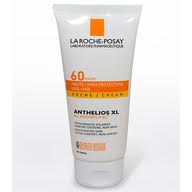Sunscreens for Body & Face
I’ll never forget the face of a fair-skinned woman in her late 30’s who came back from her tropical vacation the color of a Swiss Chalet quarter chicken, and how it shocked me to see after years of working in the beauty industry someone who actually went away and sun-tanned their face and body. This experience was as rare as seeing a Unicorn at 4pm, as most of my years were spent dutifully preaching sun-skincare advice in a gentle tone placing sparkly and matt bronzers in front of young girls seeking a Miami Beach sun-kissed glow. How could I feign sun ignorance surrounded by makeup artists and skincare experts who knew pale was the new tan before Madonna?
There’s no better lesson for sun protection then working in the cosmetics department summer after summer season (all 3 months of it...sigh...) and having women in their forties and fifties show me sun-spots, wrinkles and moles that they knew may be potential for malignant melanoma, now stocking up on the SPF 60 lotions they wished they knew to purchase 20 years ago.
That being said, if you want to know the present-day pricing of removing sun/age spots on your face here is is:
3 Laser Genesis or Photorejuvenation sessions at a popular Toronto laser clinic will set you back $624 (before HST) and 6 sessions (which may or may not remove all the sun damage) is $1,248. I believe the “big guns” are the 2D sessions (wrinkle removal also) and three will cost you $1072.
3 Laser Genesis or Photorejuvenation sessions at a popular Toronto laser clinic will set you back $624 (before HST) and 6 sessions (which may or may not remove all the sun damage) is $1,248. I believe the “big guns” are the 2D sessions (wrinkle removal also) and three will cost you $1072.
I am mostly concerned with helping you keeping an image of your future self’s skin in mind. Hold this picture in your memory when you can’t make the time (15 – 30 min) before going out into the sun to apply sunscreen on your face and body. Hold your future hand carefully...
“Up to 90% of the visible changes commonly attributed to aging are caused by the sun” skincancer.org
Again it’s the UVA rays that penetrate deep into our skin causing the long-term damage of wrinkles, age-spots, and sagging skin.
80% of skin cancer is detected in the areas of our bodies that are regularly exposed to the sun (face, neck, forearms, back of hands).
I hope you never have to say these three types of skin cancer out loud:
Basil Cell Skin Cancer:
Ultraviolet radiation from the sun is the prime cause of this skin cancer. Frequent severe sunburns and intense sun exposure in childhood increase the risk of basal cell skin cancer in adulthood.
Squamous Cell Skin Cancer:
Frequent sun exposure is the leading cause of this disease. However, people whose immune systems are suppressed through taking anti-rejection drugs face a higher risk for this disease.
Malignant Melanoma:
Excessive sun exposure plays a leading role in the development of this type of skin cancer. Severe, blistering sunburns especially in childhood are thought to play an initiating role. However, recent research shows that sunburns at any time during life can also increase the risk.
Here are products you can grab from any drugstore that offer the important UVA filters (Titanium Dioxide, Zinc Oxide, Avobenzone, and Mexoryl). If the product you have doesn’t list one as an ingredient then toss it – why use something that isn’t going to protect you from UVA rays?
Ultraviolet B rays (UVB) are the second most damaging to our skin. They are the main cause of sunburns as they are nearly 1000 times stronger than UVA rays. This is easy to remember: UVB – B for Burn.
Expiration Date:
Also…anything with a sunscreen it has an expiration date (not unlike some sandal trends) so check your half-empty foundation bottles alongside face moisturizers and sun-screens for the face to see if you need to replace them.
Your personal criteria and requirements for a sunscreen may be different then mine but this is a good checklist to start with:
ü Light Silky Finish
ü Tested on Sensitive Skin (derm-tested, non-comodegenic) if that is a concern for you.
ü Photostable/Long-Lasting Protection
ü Fragrance-Free
ü Paba-Free
ü Water/Sweat Resistant (as realistically everyone should re-apply sunscreen after splashing around in water)
La Roche Posay: You can feel definitely secure using this line as they are still the number one dermatological line in Canada. Their sunscreen products protect you from UVA/UVB using the triple threat of Avobenzone, Titanium Dioxide and Mexoryl.
Anthelios SPF 30 - 60
Ombrelle: Another L’Oreal brand that is also recognized by the Canadian Dermatology Association as it also uses Titanium Dioxide, Avobenzone (Parsol 1789) and Mexoryl SX to protect from UVA rays. It is at a cheaper price point then La Roche Posay, and comes in a variety to suit your sunny day needs. Most of them are fragrance-free, paba-free, non-greasy and water-resistant but again – you decide which one makes you happier.
Aveeno: blocks the UV rays with broad spectrum UVA/UVB protection and is fragrance-free and non-comedogendic for sensitive skin types. They truly are waterproof and non-greasy and use Avobenzone.
SPF 30 – 60 (Sprays, Lotions, and more)
LifeBrand Sunthera 3: The price is low, and it’s a recognized sunscreen using Avobenzone and Titanium Dioxide.
SPF 15 – 60
Here’s a list of recognized sunscreens from the Canadian Dermatology Association:







No comments:
Post a Comment